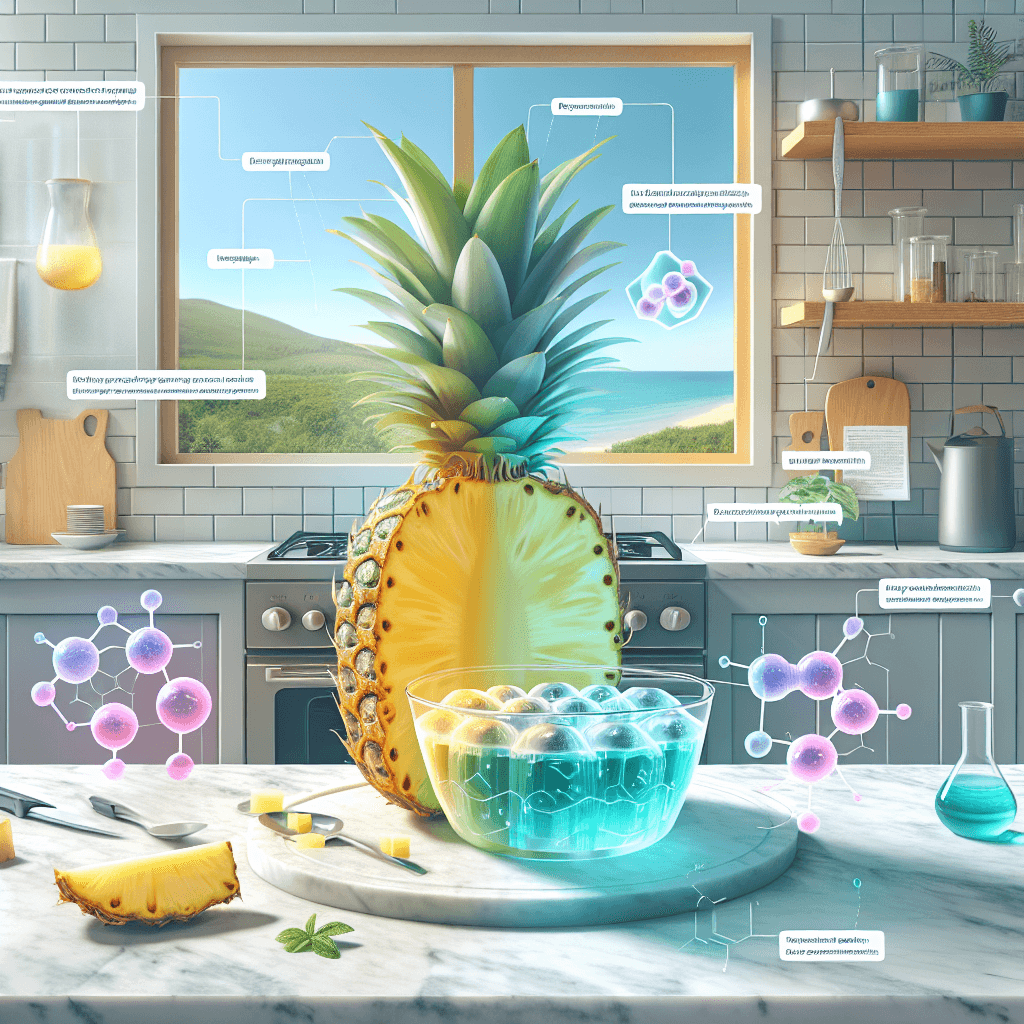Why does fresh pineapple prevent gelatin desserts from becoming solid
It's not a kitchen mistake; it's a case of culinary sabotage at the molecular level. Discover the powerful, protein-devouring enzyme in fresh pineapple that's actively digesting your dessert before it can even set.


Too Long; Didn't Read
TLDR: Fresh pineapple has an enzyme that cuts up gelatin proteins, preventing them from linking together to become solid. Canned pineapple works because the heating process destroys this enzyme.
The Culinary Culprit: Why Does Fresh Pineapple Prevent Gelatin Desserts from Becoming Solid?
Picture this: you've carefully prepared a beautiful, shimmering gelatin dessert, studded with vibrant chunks of fresh, juicy pineapple. You place it in the refrigerator with high hopes, anticipating a perfectly wobbly treat. Hours later, you pull it out, only to be met with a soupy, unset disappointment. This common kitchen catastrophe isn't a result of a faulty recipe or a refrigerator malfunction; it's a fascinating display of food science at work. The culprit is a powerful, naturally occurring enzyme found within the fresh fruit. This post will explore the precise chemical reaction behind this culinary conundrum and reveal the simple secret to successfully using pineapple in your gelatin creations.
What is Gelatin? The Science of the Jiggle
Before we can understand why pineapple disrupts the process, we first need to understand how gelatin works. Gelatin is not a single substance but a protein derived from collagen, which is found in the connective tissues of animals.
Under a microscope, these protein molecules look like long, tangled chains. When you dissolve gelatin powder in hot water, these chains unwind and disperse throughout the liquid. As the mixture cools, the protein chains begin to tangle and link up with one another, forming a complex, three-dimensional mesh or matrix. This intricate network traps the water molecules within it, creating the semi-solid, jiggly structure we recognize as a set dessert. Think of it like a microscopic sponge soaking up and holding the water in place.
The Pineapple Problem: Meet the Enzyme Bromelain
The reason fresh pineapple wreaks havoc on your dessert lies in a powerful group of enzymes it contains called bromelain. Bromelain is a type of protease, which is an enzyme specifically designed to break down other proteins. The name itself is a clue: "prote-" refers to protein, and the suffix "-ase" is commonly used to denote an enzyme.
When you add fresh pineapple to your gelatin mixture, the bromelain gets to work immediately. It acts like a pair of microscopic scissors, systematically snipping the long collagen protein chains of the gelatin into much smaller pieces. These shorter protein fragments are incapable of tangling together to form the strong, water-trapping network required for the gelatin to set. No matter how long you chill it, the fundamental structure has been destroyed, leaving you with a liquid that will never become solid.
Is It Just Pineapple? Other Problematic Fruits
Pineapple isn't the only fruit with this protein-destroying superpower. Several other fruits contain similar protease enzymes that will have the same effect on your gelatin desserts. Be wary of adding these fresh fruits to your gelatin:
- Kiwi: Contains an enzyme called actinidin.
- Papaya: Contains the well-known enzyme papain.
- Figs: Contain an enzyme called ficin.
- Mango & Ginger: Also contain proteases that can interfere with gelatin setting.
The Solution: How Heat Saves the Day
So, does this mean you can never enjoy pineapple in your gelatin? Not at all! The solution is surprisingly simple: use heat.
Enzymes like bromelain are sensitive to high temperatures. The canning process involves heating fruit to a level that effectively denatures the enzymes. Denaturation is a process where the complex, folded structure of the enzyme is permanently altered, rendering it inactive. Its "molecular scissors" are essentially broken.
This is why canned pineapple works perfectly in gelatin desserts. The bromelain has been neutralized by the heat from canning. The same logic applies to cooked fresh pineapple or pasteurized pineapple juice. As long as the pineapple has been heated sufficiently before being added to the gelatin mixture, the enzymes will be inactive, and your dessert will set beautifully.
Conclusion
The mystery of the unset pineapple dessert is a perfect example of chemistry in the kitchen. The failure of the gelatin to solidify isn't a mistake but a direct result of the protease enzyme, bromelain, in fresh pineapple actively breaking down the gelatin's protein structure. By understanding this interaction, you can easily avoid the soupy mess. Simply remember to use canned or cooked pineapple, which ensures the enzyme has been deactivated. So, the next time you prepare a gelatin dessert, you'll be armed with the scientific knowledge to guarantee a perfectly set, delicious treat every time.


